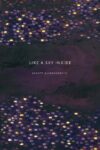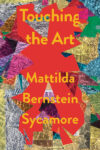
[Soberscove Press, 2021]
I was already homesick the week Joan Didion died, and happened to be reading two very California books: poet Lyn Hejinian’s brilliant, aphoristic sentence-snowball My Life, first published in 1980, and Rip Tales: Jay DeFeo’s Estocada & Other Pieces, a revelatory amalgam of biography, art thinking, interview, and personal narrative by San Francisco curator Jordan Stein, out last December. Though both of these books are mash-ups to begin with, a further textual mashing ensued as I read, an obvious puréeing of ideas, one reading corroborating the other. Both DeFeo and Hejinian were/are Bay Area natives who, while separated by a generation, long operated at what Stein terms an “edge,” that rigorous but indefinable extreme personal to every artist. “A pause, a rose, something on paper,” echoes one of Hejinian’s refrains: a redacted utterance, then a blossoming insight, makes for neither verse nor narrative, but a luminous in-between, more flexibly understood as simply something on paper—as much a description of her own project as it might be a one-line biography of DeFeo, who died in 1989. Stein quotes Defeo as an art student, writing to one of her teachers: “I wanted to create a work that was just so precariously balanced between going this way and going that way that it maintained itself.”
Rip Tales opens with one such achievement of balance, what most people know to be the achievement of DeFeo, The Rose, her behemoth sculptural painting, which she devoted herself to tirelessly in the late 50s and early 60s. But the real subject of Stein’s book is another, almost entirely unknown painting, Estocada, a bullfighting term for the matador’s final, fatal thrust. Begun not long before the completion of The Rose, on large sheets of paper tacked to the hallway of her Fillmore Street apartment, what DeFeo called a “drawing” was layered with paint so thick that Estocada became fixed to the wall. Upon her eviction in 1965, the work was subject to removal just as The Rose was, but while the latter was extracted by nine professional movers, who sawed open the face of the apartment in order to safely transport the two-thousand pound masterpiece (a now-legendary event, immortalized in Bruce Conner’s documentary The White Rose) Estocada’s de-install was less ceremonious. “Torn from the wall, the late Estocada was rogue and untethered,” eventually living in several pieces beneath the artist’s bed in Marin County. Over the course of the next ten years, fragments, evidence, and iterations of that ripped-down original would crop up again and again in DeFeo’s oeuvre—as discreet paintings, photographs, collages, photocopy experiments, and various combinations therein: “a series of gestures that might be interpreted as conceptual were it not so rooted in real-time material discovery.” Of The Rose, DeFeo noted, “Everything I’ve done is in there,” prompting the inevitable question, then what wasn’t? What might explain the impetus for Estocada, and DeFeo’s repeated returning to its remains, if we understand it as somehow beyond, or in spite of, or in opposition to such a consuming everything?
Stein’s inquiry is rooted in an earnest curiosity that resists the narrows of both interpretation and nostalgia. “If The Rose risks mythologizing, so too does its destroyed shadow. Artists commit to artwork and intuitions all the time, and for reasons that ultimately remain ordinary, personal, and unknowable,” he writes. Rip Tales is so successful because it is expansive—reaching far beyond the frame of its initial terms. As if spurred by his subjects’ own disavowal of orthodoxies and definitions, Stein’s storytelling embraces a constant shifting, both of form and focus. The quest to uncover Estocada becomes an occasion for encounters with eight other artists, all with deep ties to the Bay, including Trisha Donnelly, Ruth Asawa, Dewey Crumpler, April Dawn Alison, Lutz Bacher, Zarouhie Abdalian, Vincent Fecteau, and Bruce Conner. Through interviews, remembered conversations, a transcribed lecture, and curatorial documents, he offers both a collection of nuanced portraits, and a glimpse into the many visions and approaches that give rise to art-making, as varied as their practitioners. In one of the book’s most personal chapters, Stein recounts something of his own becoming, as a student of Trisha Donnelly’s at the San Francisco Art Institute, in a brimming description of art’s capaciousness: “Through long, generous, unpredictable conversations and observations, art emerged as a private and idiosyncratic language, born not from a careful school of thought but instead from a tangle of inklings and affectations, commitments and contradictions, expectations and embarrassments, reflections and suspicions: a stew of propositions inspired by lived and imagined experience. Why shouldn’t art be as simultaneously giving and withholding as the world?”
It should! we agree. Yes! In keeping with real pre-Zuck San Francisco spirit, from the Beats to Brautigan to the language poets, give everything you can; withhold anything you want; such is the imperative and prerogative of the artist, whatever the risks, audience and establishment be damned. The threat of the subtext can’t be a deterrent: but what if the artist is left with nothing?
Stein describes how, throughout the 70s and 80s, when DeFeo embraced new, oft-dismissed photographic methods with the same seriousness of attention she brought to painting, The Rose, having nowhere else to go, found storage down the hall from her classroom at the Art Institute, just off the school café, where it lived like any unappreciated piece of institutional décor until extra space was needed to display student work. The masterpiece was covered by a particleboard wall, “effectively buried alive.” A similarly heartbreaking concealment haunts the intimate self-portraiture of April Dawn Alison, the private female persona of Alan Schaefer, whose trove of over 8,000 polaroids weren’t discovered until long after her death. Told through an interview with the discoverer of Alison’s archive, artist Andrew Masullo, her legacy is marked by all that’s missing—a cohesive narrative; a series of explanations and proper nouns; all we expect to make a life legible. And yet the evidence that does remain—so many captured gestures, particular postures, embodied attitudes—evokes more of the artist, in all her nuance and multiplicity, than any biography ever could. Such extraordinary traces of livingness, such mysterious invitations, might be right under our feet all the time, Rip Tales’ tales suggest, summoning the title’s potential as pun. Silent, obscured, resting in peace or entirely lost, all they need is our notice to awaken. A Lutz Bacher piece Stein describes, a contribution to his very first curatorial project in Philip Johnson’s Glass House, consists of a single fortune freed of its cookie, to be displayed on a coffee table where another sculpture, a disappeared Giacometti, once lived. The fortune reads: “Develop an appreciation for the present moment.”
Stein notes that Bacher’s slip of paper had to be secured to the table by a tiny piece of museum wax to prevent its blowing away. “Art’s most thrilling and precarious property may be its resemblance to trash,” he writes. Music composed of silence, words freed of sentences, sculptures made of pocket lint inside plastic cigarette-pack wrappers: work that approaches detritus risks perception as both invalid and without value—it’s not a collage, it’s just studio scraps—both by the modesty of its materials and because it is so difficult to verify, lacking traces of intention, or even of an artist at all. In its audacious disregard for approval, such work unsettles its audience perhaps as much as it liberates its creators.
I hope I’m not spoiling too much to reveal that when the final iteration of the former Estocada is discovered, its form might be mistaken for such a studio scrap, were Stein and DeFeo’s archivists not so carefully attuned to the clues. DeFeo is revealed to be troubling along another precarious edge, which Stein redefines as a “free space warranting song, prayer, or exclamation.” To my surprise and delight, Hejinian makes an appearance in this late chapter (had I willed it? Had I, like any good reader, collaborated somehow?) when he describes her own recognition of the ambiguous limits of understanding. He quotes the poet, “To know that things are is not to know what they are, and to know that without what is to know otherness . . . a notion that can be offered in a political, as well as an epistemological context.” Is it enough to only ever half-know what we’re doing, what we’re making, and why? Is it enough to circle only questions, never to arrive at answers? Plenty of artists, now and before us, have thrived, on their own terms, in the half-knowing, in the unresolved. Why shouldn’t we?
Leigh N. Gallagher is a fiction writer originally from California. Her first novel, Who You Might Be, will be released in June, 2022.
This post may contain affiliate links.







